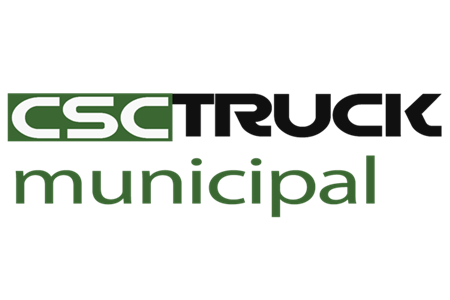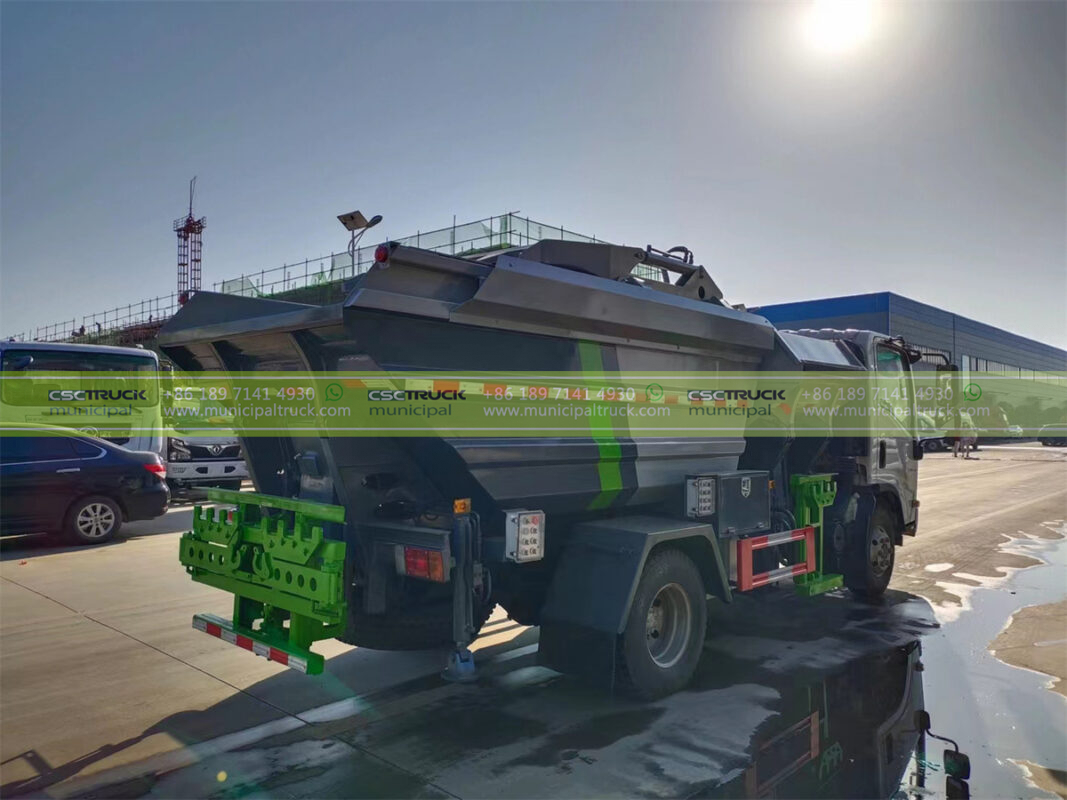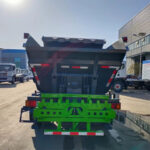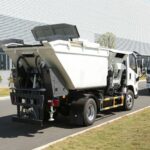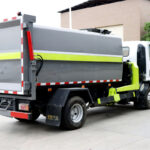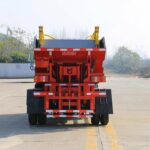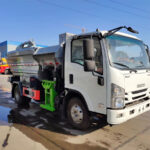As municipal budgets strain under the dual pressures of inflationary labor markets and expanding urban populations, a quiet revolution is rumbling through residential streets at dawn. Self-tipping garbage trucks —once a speculative concept—have emerged as the operational backbone of financially sustainable waste collection in 2025. These AI-integrated systems leverage robotics, advanced sensor arrays, and predictive analytics to eliminate the most labor-intensive element of refuse collection: the manual hoisting of bins. With municipalities like Gothenburg and Phoenix reporting 38-42% reductions in collection crew sizes within months of deployment, this technology transcends incremental improvement, fundamentally rewriting the cost structure of urban sanitation.
The Labor Cost Crisis: Why Automation Became Imperative
Traditional waste collection’s economic model has fractured under contemporary pressures:
- Demographic Squeeze: 27% of experienced waste handlers retired between 2023-2025, creating a skills gap that increased training costs by 300%
- Injury Economics: Repetitive strain injuries from bin-lifting cost North American municipalities $1.4 billion annually in workers’ compensation claims
- Route Inefficiency: Human-paced collection limits routes to 700-900 stops/day versus 1,400+ for autonomous systems
- Overtime Dependencies: Post-pandemic staffing shortages forced 63% of cities into unsustainable 25%+ overtime premiums
The tipping point arrived when labor crossed 68% of total collection costs in major metros—a threshold where automation delivered ROI within 18 months rather than years.
Anatomy of Autonomy: Core Technologies Enabling Self-Tipping
Modern units integrate four interdependent systems that transform passive vehicles into intelligent actors:
Robotic Arm Matrix
Hydraulic manipulators with force feedback:
- Execute 270-degree radial coverage without repositioning
- Detect bin weights from 5kg to 240kg with 98% accuracy
- Self-calibrate grip pressure to prevent plastic bin deformation
- Achieve 9-second bin-to-hopper cycles versus 23 seconds manually
Seoul’s deployment demonstrated 99.7% successful lifts despite icy winter conditions through heated grip sensors.
Cognitive Vision Systems
Multi-spectral imaging arrays:
- Classify bin types (wheeled/standard/special waste) at 40m distance
- Identify obstruction risks (parked cars/overhanging branches)
- Detect contamination through hyperspectral material signatures
- Navigate complex cul-de-sac maneuvers without driver input
Melbourne’s fleet reduced “missed collection” complaints by 87% through real-time bin detection analytics.
Operational Synergies: Beyond Labor Reduction
The true value emerges when self-tipping integrates with broader waste streams:
Dynamic Compaction Intelligence
AI-coordinated compactor garbage truck systems:
- Adjust compression cycles based on real-time waste density
- Optimize route sequencing to balance truck payload distribution
- Auto-schedule transfer station runs at 89% capacity thresholds
- Reduce fuel consumption by 14% through mass optimization
Singapore’s integrated system increased average payload density from 450kg/m³ to 710kg/m³, eliminating 12,000 annual collection trips.
Predictive Maintenance Networks
Self-diagnosing mechanical ecosystems:
- Monitor hydraulic fluid viscosity degradation
- Predict arm joint wear through vibration pattern analysis
- Auto-order replacement parts via municipal procurement APIs
- Reduce maintenance downtime from 34 hours/month to 6
Oslo’s fleet achieved 98.2% operational availability through such systems, critical during harsh Nordic winters.
The Financial Calculus: Quantifying the Labor Dividend
2025 deployment data reveals transformative economics:
| Cost Factor | Traditional Collection | Self-Tipping Operation | Reduction |
|---|---|---|---|
| Crew Wages | $214,000/truck/year | $121,000/truck/year | 43.5% |
| Workers’ Comp | $18,700/truck/year | $2,300/truck/year | 87.7% |
| Route Coverage | 8.2 km²/truck/day | 14.6 km²/truck/day | +78% |
| Fuel Efficiency | 3.1 mpg | 4.6 mpg | +48% |
| Vehicle Lifespan | 7 years | 11 years | +57% |
Amsterdam’s 18-month pilot showed 22% total cost reduction per ton collected despite 40% higher truck acquisition costs.
Workforce Evolution: From Laborers to Technicians
Contrary to job-replacement fears, automation has triggered strategic reskilling:
Remote Fleet Supervision
Centralized control hubs:
- Monitor 40+ trucks simultaneously via augmented reality interfaces
- Intervene in <15 seconds for complex lift scenarios
- Analyze route efficiency through machine learning algorithms
- Generate automated safety compliance reports
Los Angeles transitioned 68% of former loaders to these roles at 31% higher wages with full benefits retention.
Field Maintenance Specialists
On-demand technical response teams:
- Diagnose mechatronic failures via AR-assisted troubleshooting
- Perform robotic calibration using laser alignment tools
- Manage fleet software updates during overnight windows
- Train AI vision systems using localized waste pattern data
Toronto’s union agreement created 94 new technician positions paying $32/hour—23% above previous loader wages.
Municipal Integration: Embedding Autonomy into Urban Fabric
Successful deployments leverage cross-system interoperability:
Smart Bin Ecosystems
IoT-enabled waste containers:
- Transmit fill-level data to optimize collection frequency
- Identify resident non-compliance through weight anomalies
- Trigger special collections for hazardous materials
- Interface with variable-rate billing systems
Hamburg’s sensor-integrated bins reduced unnecessary collections by 31%, extending vehicle service intervals.
Traffic Flow Synthesis
Real-time urban navigation:
- Integrate with traffic management APIs to avoid congestion
- Auto-reschedule routes during festival/construction disruptions
- Coordinate with public transit movements for corridor access
- Reduce neighborhood disruption through noise-minimized routing
Tokyo’s coordination with traffic lights cut idle time by 44 minutes per truck daily.
The Future Horizon: Where Autonomy Meets Circularity
As dawn breaks over Barcelona’s Eixample district, the synchronized dance of garbage truck fleets reveals a new municipal paradigm. These self-tipping sentinels, working alongside advanced compactor garbage truck units, have evolved beyond cost-cutting tools into data-generating infrastructure assets. Their robotic arms now execute waste streams choreography with balletic precision—each lift simultaneously reducing operational expenses while harvesting material intelligence for circular economy initiatives. In the whir of their servo motors and the algorithmic optimization of their routes, fiscally strained cities discover resilience: a future where reduced labor costs fund expanded sustainability programs, where mechanization creates higher-skilled jobs, and where the humble municipal truck transforms from cost center into intelligent steward of urban metabolism. The revolution isn’t coming; it’s already at the curb, emptying bins with silent efficiency while reallocating human ingenuity toward higher-value municipal service.
